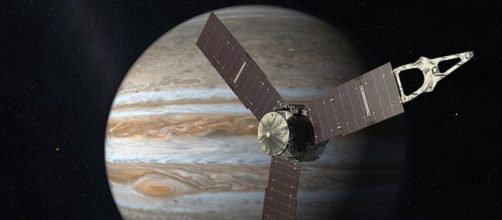Jupiter Near-Polar Orbiter (Juno) is a NASA spacecraft currently in the direction to meet Jupiter. Juno is travelling at about 96,000 km (60,000 miles) per hour and is expected to arrive on Jupiter on July 5, 2016. Once there, Juno will be placed in a polar orbit to study the planet´s composition, magnetic field, polar magnetosphere, and the planet´s interior.
Juno
The spacecraft was launched on August 5, 2011. On July 4, 2016, it will undergo a Jupiter insertion maneuver that will place it in a polar orbit around that planet. It will go around the planet for 37 times at a distance of 5,000 km (3,100 miles) above the top clouds.
During its flyby's, the spacecraft will measure the planet´s gravity and analyse beneath the dark cloud of gas in Jupiter.
Why study Jupiter?
Even though various spacecrafts have visited this planet, there is still not enough information about the composition of this gas giant. Scientists know that hydrogen and helium account for 99% of this planet´s structure; however, the remaining 1% of its composition is not really known. It´s also not known whether a center core produces the planet´s powerful magnetic field.
Searching for water
One of the biggest mysteries about Jupiter deals with its content of water. It´s known that it´s made principally of hydrogen and one quarter is helium, but not exactly the quantity of heavy element that compose it.
Oxygen, the most important heavy element, is the third most abundant element in the universe. It´s believed that Jupiter could contain a little more than one-half of Jupiter’s heavy element composition, which could account for 20 times the mass of the earth.
Dipping into Jupiters' atmosphere
Based on previous studies, Jupiter is composed of heavier elements, heavier than hydrogen and helium. It´s believed that Jupiter has a solid core; however, to date, its been impossible to verify this assumption. It´s also not known whether the core is solid or if the gases near the interior become denser, gradually being pushed together by gravity and becoming a solid ball in the center. Different theories try to explain the formation of Jupiter -- the size and mass of its core.
Some models predict that the core could account for as many as 20 earths. Juno´s flyby's at the poles and studying the gravity and magnetic fields in Jupiter will reveal the planet´s interior and whether it has a solid or liquid core.

